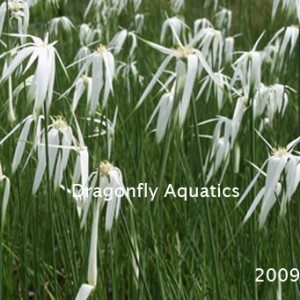 Introducing a New plant for 2009. Star Grass (Dichromena colorata) A tiny white star shaped flower appears atop grasslike leaves with a bold center. This bog plant grows to 24-36 inches tall. It grows well in bogs or in a pot with about 2 inches or less of water above the top of the pot. It likes high moisture. Requires sun to partial shade and will bloom starting in the spring throughout the summer season. Considered a tropical bog plant but is hardy zones 7a through 10.
Introducing a New plant for 2009. Star Grass (Dichromena colorata) A tiny white star shaped flower appears atop grasslike leaves with a bold center. This bog plant grows to 24-36 inches tall. It grows well in bogs or in a pot with about 2 inches or less of water above the top of the pot. It likes high moisture. Requires sun to partial shade and will bloom starting in the spring throughout the summer season. Considered a tropical bog plant but is hardy zones 7a through 10.
Buy Star Grass, bog plant here.
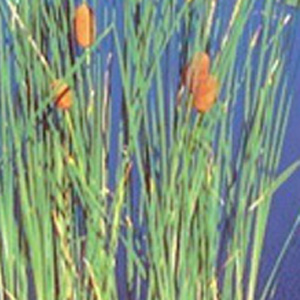 Dwarf cattail are miniature cattails, a direct replica of the regular cattail, it is best for smaller ponds or water containers. They have dark grassy foliage and chunky, rounded, dark brown seed heads. Dwarf cattail are not invasive. They like moist soil to 2 inches of water in full sun. They will grow to approximately 18 inches in height. They flower during the summer, but the main attraction comes in the fall when the brown heads appear. Dividing cattails should be done in the early spring.
Dwarf cattail are miniature cattails, a direct replica of the regular cattail, it is best for smaller ponds or water containers. They have dark grassy foliage and chunky, rounded, dark brown seed heads. Dwarf cattail are not invasive. They like moist soil to 2 inches of water in full sun. They will grow to approximately 18 inches in height. They flower during the summer, but the main attraction comes in the fall when the brown heads appear. Dividing cattails should be done in the early spring.
Buy dwarf cattail,hardy bog plant here.
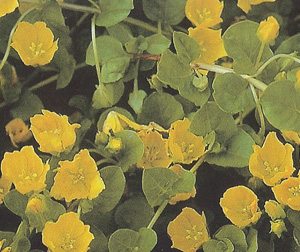 Creeping jenny is an excellent cover for edges of water gardens or waterfalls. It grows to about 1-2 inches and creeps in the moist soil or water to 1 inch deep. Its rounded leaves will clasp onto other leaves and form a tight clump of foliage with yellow, buttercup-like flowers appearing throughout the summer. It will grow in sun or shade. You can take short stem cuttings of this plant and begin new ones in a mixture of equal parts peat and perlite.
Creeping jenny is an excellent cover for edges of water gardens or waterfalls. It grows to about 1-2 inches and creeps in the moist soil or water to 1 inch deep. Its rounded leaves will clasp onto other leaves and form a tight clump of foliage with yellow, buttercup-like flowers appearing throughout the summer. It will grow in sun or shade. You can take short stem cuttings of this plant and begin new ones in a mixture of equal parts peat and perlite.
I always have this plant in several areas of my pond covering rock edges, waterfalls and areas in my bog that I like to hide. Its an easy plant to grow and is enjoyed by its bright yellow flowers and attractive foliage.
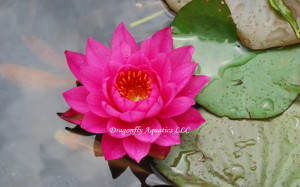 The Mayla Hardy Water Lily is a vibrant deep rose-pink lily. One would think it was a tropical lily because of its fuschia color. It has peony-shaped blooms the open 5-6 inches with dark green leaves. It grows to 6-12 feet wide in the full sun. Best planted at 6-24 inches of water above its container. The lily is considered a medium to large. If planted in a soil pond it will cover a large area quickly. A favorite among pond owners.
The Mayla Hardy Water Lily is a vibrant deep rose-pink lily. One would think it was a tropical lily because of its fuschia color. It has peony-shaped blooms the open 5-6 inches with dark green leaves. It grows to 6-12 feet wide in the full sun. Best planted at 6-24 inches of water above its container. The lily is considered a medium to large. If planted in a soil pond it will cover a large area quickly. A favorite among pond owners.
Buy Mayla Hardy Pond Lily,here.
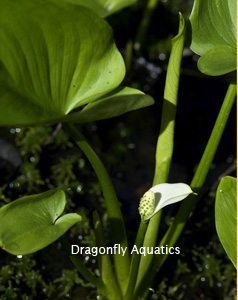
![]() Arrowhead plants are one of the easiest pond plants to grow. Whether in your natural pond, water garden pond or container water garden, they contribute much to the landscape with their clean, geometric foliage and delicate small white flowers. These pond plants are highly recommended for your pond edge. They require Sun to Part Shade and will tolerate cold temperatures. Hardy Zones 3 to 11. Arrowhead plants like water depth from moist soil to 2 inches overall, but certain varieties will tolerate deeper water.
Arrowhead plants are one of the easiest pond plants to grow. Whether in your natural pond, water garden pond or container water garden, they contribute much to the landscape with their clean, geometric foliage and delicate small white flowers. These pond plants are highly recommended for your pond edge. They require Sun to Part Shade and will tolerate cold temperatures. Hardy Zones 3 to 11. Arrowhead plants like water depth from moist soil to 2 inches overall, but certain varieties will tolerate deeper water.
Their clean, geometric foliage and delicate white tiny flowers contribute a nice focal point to your water feature. Named for the shape of their leaves, arrowheads are easy pond plants to grow at the pond edge. The foliage may be narrow or broad, depending on which arrowhead you select, some even having lobed leaves. Their flowers appear first in June and reoccur throughout the summer.
The most common is the Arrowhead ( Sagittaris latifolia). It has arrowhead shaped leaves and produces a tiny white flower with yellow centered blooms and grows 12 - 20 inches high with a running spread. Hardy zones 3-11. The common arrowhead can take deeper water depth. Anywhere from moist soil to water 6 inches or more deep. Its leaves will even grow submerged.
Double-flowering Arrowhead (Sagittaria japonica) is very similar to the common arrowhead but produces a double white flower, resembling a tiny white rose. This plant grows to 2 ft tall. Hardy zones 3-11.
"Silk Stocking" Arrowhead (Sagittaria aistralis 'Benni") has striking, variegated maroon leaves. Clusters of tiny white, yellow centered flowers appear throughout the summer. It will grow to 2 ft. tall. The new growth of this arrowhead appears red and the older foliage looks smokey with a red overlay. Hardy in Zones 5-11.
Variegated Arrowhead (Sagittaria graminea 'Crushed Ice') is a distinctly variegated leaf. It has cream white blotches on each slightly twisted leaf and blooms white flowers in clusters with yellow centers. Grows to 12" to 24" tall and is hardy in Zones 5-11. It will grow in most soil to submerged in up to 5 ft. of water. A very striking plant.
Arrow Arum (Peltandra virginica) isn't an arrowhead but is very similiar. The plant forms a dense clump as do the arrowheads. Grows to about 24" high and can spread to 24" wide. A very light green to white flower will appear resembling a jack-in-the-pulpit. It takes moist soil or water to 6 " deep or more in sun to part shade. Hardy Zones 5-9. Shown in picture.
Purchase arrowhead,crushed ice,arrow arrum, here.
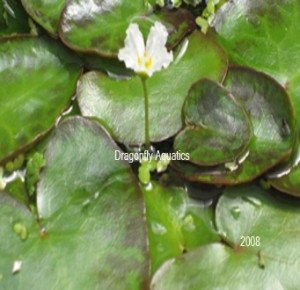 Frogbit (Limnobium spongia) Clusters of heart-shaped leaves float on the water surface. This lovely little floating plant looks like a tiny waterlily. It has small shaped leaves that are produced in neat rosettes and tiny white petalled flowers with yellow centers. Grows in sun to part shade with a running spread, reaching about 1/2 inch tall. Hardy in Zones 7-10. You can divide this plant during the growing season.
Frogbit (Limnobium spongia) Clusters of heart-shaped leaves float on the water surface. This lovely little floating plant looks like a tiny waterlily. It has small shaped leaves that are produced in neat rosettes and tiny white petalled flowers with yellow centers. Grows in sun to part shade with a running spread, reaching about 1/2 inch tall. Hardy in Zones 7-10. You can divide this plant during the growing season.
Another plant that will float on your water surface creating shade for your fish and helping with water clarity.
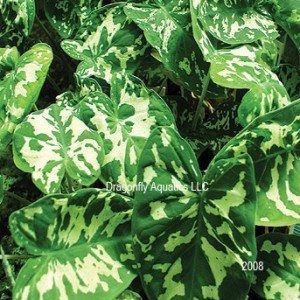 There are several different types of Taro Plants and although they are considered a tropical plant they are one of the easiest plants to winter over as a houseplant. Large leaves and each growing to heights of 2' to 4' high with leaves up to 24". Taro or sometimes called elephant ears, are native to the tropics of Asia. There are more than 300 varieties that are grown in the U.S., especially in Hawaii. They are also grown for a food crop, since all their plant parts can be eaten. You can cook the stems, leaves and flowers while they are young and eat as a vegetable. The leaves are often used to wrap other food with and them steamed.
There are several different types of Taro Plants and although they are considered a tropical plant they are one of the easiest plants to winter over as a houseplant. Large leaves and each growing to heights of 2' to 4' high with leaves up to 24". Taro or sometimes called elephant ears, are native to the tropics of Asia. There are more than 300 varieties that are grown in the U.S., especially in Hawaii. They are also grown for a food crop, since all their plant parts can be eaten. You can cook the stems, leaves and flowers while they are young and eat as a vegetable. The leaves are often used to wrap other food with and them steamed.
But to us ponders we simply love the look and gracefulness of the Taro. It can add a dramatic accent to your pond or container garden. Taros are quite often used as a plant for a container planting. They can tolerate full sun but they prefer to be protected from the afternoon sun. They need to be fertilized regularly and planted in large pots to grow them to their maximum size. You'll have larger leaves and larger plants. Planting zones are 9-11 and require moist soil or water to 6 inches deep.
To winter over a Taro simply bring indoors and keep in a sunny, warm room in a container of water. You can also cut the plant slightly above the tuber and store the dried tuber in coarse vermiculite in a sealed container and replant in the spring. You can also take the plant and let it dry and store it in the pot in a cool, dark spot where it will become dormant until you bring it out again in the spring.
I will feature the different Taros in upcoming plant posts. Stay tuned to the many varieties of Taros available for your container garden or pond.
The picture here is a Variegated Taro (Alocasia amazonica 'Hilo Beauty' . This Taro plant is very stri8king with its lush green leaves that are mottled in ivory. It likes to be just at or slightly above the water surface. Grows in sun to part shade and is Hardy in Zones 9-11. The ideal temperature for year around growth is 65 degrees. In the cooler, but frost free areas it becomes dormant during the winter. You can store the tubers in sand during the winter. Propagation: By division of the tubers if the plants are lifted during the autumn, or just before they come into growth in the spring.
Buy Taro,Variegated,Green,Black,Imperial, here.
I spent the day taking pictures of planting a tropical lily from our greenhouse to demonstrate how easily this can be done. Start with a nice size pot. I used a 16"x7" small lotus/lily container. The first picture is an example of one of our lilies that you would receive on your order. It's considered a bare root tropical lily.
Planting a tropical lily is different than planting a hardy lily. You want to make sure you get a large container so that the lily can perform at its best. It is recommended that a 2 - 7 gallon pot be used. When you first receive them remove from the plastic bag they arrive in and keep the plant wet and out of the sunlight. Put in a tray of pond water in the shade to re-hydrate it until you can plant it. The soil can be out of your flower or vegetable garden. Heavy soil with some clay base is good. You should stay away from commercial potting soils as they are too light and will float to the top of your pond. Clay kitty litter mixed with some sand will also work, if clay is not available in your area of the country. Inexpensive clay kitty litter ("calcified clay", non-deodorized, making sure it hasn't been chemically treated or deodorized.)
Topical Water Lilies are shipped "bare root" with 3 to 8 leaves and sometimes buds and flowers on them, although these may die back during the transplanting, the lily will immediately start sending up new leaves and buds. Tropical Water lilies should be planted in 2 to 7 gallon pots. A larger container will produce larger and more profuse flowering. Fill the container about half-way with a heavy clay based soil. Scoop out a section in the center of the pot. Place the tuber and roots upright in the center of the pot. Fill and firm the soil around the roots leaving the crown (where the stems and roots connect) level with the soil line keeping the crown exposed. You can then add one fertilizer tablet per gallon of soil, keeping it away from the roots. I like to top it with about an inch of pea gravel or larger size gravel to hold the soil in place, remembering to keep away from the crown of the plant. Next you can gently rinse the newly potted plant to lessen the mud escaping as you lower the pot into your pond. You should lower it to a depth of approximately 6" to 8" over the crown of the lily. Once the lily gets established you can then lower it to a depth of 12" to 18" over the crown. Tropical water lilies cannot tolerate temperatures below 65 degrees and should not be planted until the water temperatures reach and are stabilized at 70 degrees. The Night Blooming Tropical Lilies should not be set out until water temperatures have stabilized closer to 75 degrees. Planting too early can result in dormancy or cause your lily to die. Lilies are heavy feeders and should be fertilized about every 4 weeks with one fertilizer tablet per gallon of soil throughout the growing season.
It won't take long for your Tropical Water Lily to start growing and producing flowers. You can relax once again and enjoy the brillant colors of the Tropical Water Lilies.
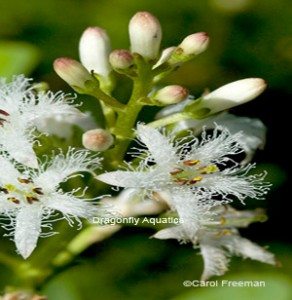 Bog Bean (Menyanthes trifoliata)
Bog Bean (Menyanthes trifoliata)
A favorite hardy bog plant is the Bog Bean. It has large, three leaves that are veined. The foliage forms a creeping rhizome that floats out onto the water. The flowers are pink clusters that open to white, star-shaped blooms that are highly fragrant. The flowers will appear late April through July whereas the foliage will appear lush throughout the whole season. The flower stalks will stand 2-6 inches high above the leaves which are about 3 inches high. It does best if planted in 1 - 3 inches of water and will then creep out onto your water surface, extending 3' to 5'. It prefers full sun to part shade and is hardy in zones 2-7 and should be kept in the water throughout the winter even if it freezes.
Buy Bog Bean, Hardy Bog Plant, here.
Use a container that is shallow and wide. Dwarf varieties, such as 'Chawan Basu' and 'Momo Botan' should be planted in containers at least 24 inches in diameter with a depth of 10-12 inches. Your regular size lotus do best in containers that are 3 feet in diameter. Planting lotus in smaller containers crowds them, resulting in fewer or no blooms.
Place clay soil into your pot. You want to put about 5 inches of dirt into your pot. Any more dirt in the container is unnecessary and may result in the container being too heavy to move. Then place the lotus tuber on top of the dirt with the cut edge of the rhizome against the edge of the pot.
Next take a flat rock and place it on top of the tuber. It isn't necessary to put dirt on top of the tuber. It will grow down into the dirt. The rock just keeps it positioned and keeps it from floating to the top of the container. You would next add about 2-3 inches of water to cover the tuber. Keep the container in a warm sunny location as the plant establishes itself. You will need to add water to compensate for evaporation as necessary. Once the lotus has produced several leaves, a shallow layer of soil may be added to cover the tuber, but isn't necessary. You want to be careful so you don't break the growing tip. At this point you can add a small gravel topping if desired.
Once the lotus has several leaves you can begin to lower it into your pond making sure you don't put the leaves under water. Eventually getting the container to the depth you want it. You can be quite successful growing a lotus in the container sitting on your porch or deck without putting it in a pond. Just make sure you keep adding water as it evaporates.
Now sit back and enjoy the fruits of your labor.